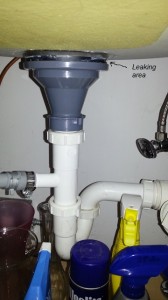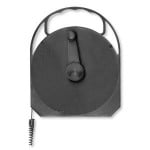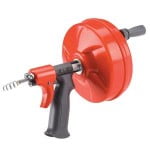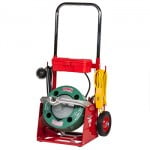I’m a novice when it comes to plumbing issues, but I did learn a bit with this episode. We have a dual sink in our kitchen, and one side has a garbage disposal. The sink seemed to be going down fine, but then when we ran the garbage disposal, the 2nd sink on the other side started to back up messy water filled with food bits. I assumed the garbage disposal was chopping up bits and unable to drain quickly enough, so the water backed up on the other side.
Like most people, I went ahead and did a Google search and found plenty of sites with suggestions on how to unclog a kitchen sink. The advice seems to go from slightly helpful to just bad advice. Most of the suggestions center on:
1. Plunger
2. Baking Soda mixed with vinegar
3. Snake
It seems that the garbage disposal can act as a pump and push the water out more quickly than the regular faucet, which can lead to the water backing up out of the other sink. After turning off the disposal, the water from the 2nd sink would go down some but the water would back up on the disposal side. After doing a bunch of reading, it seemed pretty clear the problem in my case was a blockage beyond where the two sink drains join, and it wasn’t a complete blockage as the water would slowly go down after a while.
I did not want to use chemical drain cleaners like Drano as I’ve heard they are bad for your pipes. Reading a bit more on the topic maybe it isn’t so much they are bad for modern pipes, but they are dangerous, bad for the environment, and if you have a clogged line that doesn’t get cleared, it means the chemicals are there when you remove the pipes which can be very dangerous.
I figured the plunger route sounded reasonable as I’ve had good success with using plungers on the toilets. Some sites suggest using a special sink plunger that has a flat bottom as opposed to the toilet plungers with the lip. I was not about to go to the store to get a new plunger, so I used the toilet plunger. Common sense says to make sure it is clean, or be prepared to do a very good job cleaning your sink as there are probably some bad bacteria on a toilet plunger.
I learned the hard way that you need to be aware that using a plunger on a kitchen sink is not an entirely harmless process! First, I held a drain cover down over the disposal side of the drain and with a few inches of water in the other side, I started to plunger away. I could hear water swishing around a little and was hoping I was making process. The water wasn’t really going down, so I tried a little bit harder. The water swishing sound seemed to get a bit louder and then I noticed that my feet were feeling wet. Not good. Not good at all.
I opened the cabinet under the sink to have a look and I noticed a bunch of water dripping from the pipes. Did I actually burst a pipe? Or was it just a leaking connection? I first had to scramble to do some cleaning – lots of towels and a few buckets to get things dried up and quickly as possible and then the bucket to catch any further leaks.
With a bit of exploring, I found that the leak was coming from under the drain on the sink.
 I’ve attached a picture here. You can see my fine photoshop skills pointing to the spot where I noticed the water leaking. You can also see a bit of the anatomy of my plumbing. This is the side without the garbage disposal, located on the left of the double sink. The grey funnel is actually a non-standard style kitchen sink drain (just my luck). The hose linking off the left of the picture I believe goes to my dishwasher, but it goes up towards the counter, probably to avoid some kind of backflow? However it is situated, it did keep the excess sink water from draining into my dishwasher (as best I could tell). I do think that my plunging was likely not as effective as it could have been because of this extra hose. The water swooshing around that I heard (that wasn’t leaking out) was probably just water going into and out of the dishwasher.
I’ve attached a picture here. You can see my fine photoshop skills pointing to the spot where I noticed the water leaking. You can also see a bit of the anatomy of my plumbing. This is the side without the garbage disposal, located on the left of the double sink. The grey funnel is actually a non-standard style kitchen sink drain (just my luck). The hose linking off the left of the picture I believe goes to my dishwasher, but it goes up towards the counter, probably to avoid some kind of backflow? However it is situated, it did keep the excess sink water from draining into my dishwasher (as best I could tell). I do think that my plunging was likely not as effective as it could have been because of this extra hose. The water swooshing around that I heard (that wasn’t leaking out) was probably just water going into and out of the dishwasher.
Now I had two problems – a backed up kitchen sink, and a leaking kitchen sink drain. The leaking kitchen sink drain now became my main priority. As all good novice plumbers do these days, I again went to search Google for how to fix a leaking sink drain. I got a lot of responses again, with some of the most helpful being YouTube videos. Unfortunately, nothing in the videos matched how my drain looks. Uh-oh. I could not figure out for the life of me how to get this drain removed. I was able to loosen the connection between the grey drain and the white piping under it without too much trouble. The other pipe connections were very tight, even though they are hand tightened connections. I was at least able to rotate the trap out of the way.
The problem with removing the drain was that there was no large nut underneath the sink holding the drain in place. The grey housing just would spin and nothing would tighten or loosen. I wound up taking a picture of this to Home Depot to see if they had any suggestions on how to remove the drain, replace it, and also fix my clogged sink. A few of the staff there said they had never seen a kitchen sink drain like that before, but the most helpful guy said there must be a way to separate the top from it and maybe I need to remove it from the top side.
 When I got home I took a closer look. I’m not sure how well this can be seen over the web, but the center of my drain had a screw that a nickel can be used to tighten and loosen. If you look under the drain, you see some blade looking things which are actually connected to the grey funnel shaped housing underneath. When I spin the housing underneath, those blades rotate with it, but not the rest of the drain. I was able to hold the funnel shaped housing in one hand while loosening the screw on top. Voila – the grey underside of the drain came loose, with a large black gasket between the housing and the underside of the sink basket. Hmmm. Perhaps the drain was fine and I really just needed to tighten the screw to better compress the gasket. I didn’t think of that right away. Instead, I had already pried out the drain basket and had my plumber’s putty I bought at Home Depot in hand. I went ahead and removed all of the gross crap and plumber’s putty from the drain. Laid out a new roll of plumber’s putty, pressed the drain back into place, and then re-attached the underside funnel and gasket with the screw on top. I tightened it up pretty good and removed the excess putty. It looked pretty good for a novice plumber, even if I probably didn’t need to go through all of that effort. I did fill the sink up and it didn’t seem to be leaking, so at least one of my problems seemed fixed. Nothing better than making a simple solution (tightening the screw) into a complex solution (removing and reattaching the entire drain).
When I got home I took a closer look. I’m not sure how well this can be seen over the web, but the center of my drain had a screw that a nickel can be used to tighten and loosen. If you look under the drain, you see some blade looking things which are actually connected to the grey funnel shaped housing underneath. When I spin the housing underneath, those blades rotate with it, but not the rest of the drain. I was able to hold the funnel shaped housing in one hand while loosening the screw on top. Voila – the grey underside of the drain came loose, with a large black gasket between the housing and the underside of the sink basket. Hmmm. Perhaps the drain was fine and I really just needed to tighten the screw to better compress the gasket. I didn’t think of that right away. Instead, I had already pried out the drain basket and had my plumber’s putty I bought at Home Depot in hand. I went ahead and removed all of the gross crap and plumber’s putty from the drain. Laid out a new roll of plumber’s putty, pressed the drain back into place, and then re-attached the underside funnel and gasket with the screw on top. I tightened it up pretty good and removed the excess putty. It looked pretty good for a novice plumber, even if I probably didn’t need to go through all of that effort. I did fill the sink up and it didn’t seem to be leaking, so at least one of my problems seemed fixed. Nothing better than making a simple solution (tightening the screw) into a complex solution (removing and reattaching the entire drain).
 Now I’m back to where I started – with a clogged drain. Now that I felt my drain was more solidly in place, I did try to plunger it again a few times. No luck. While I was at Home Depot, the guy convinced me to buy this special “drain snake” that is a complete piece of crap. I had asked if I should buy one of the larger snakes which attaches to my drill, and the guy side that wouldn’t be necessary. The type the guy sold me is pictured here, and it was around $7. It consists of a small coil spring on the end attached to a flat ribbon style metal band that can extend up to 20 feet. It was VERY difficult to get through the pipe because it is fairly rigid. I am guessing it has to be rigid in order to work as it works by pushing and pulling the clog out of the way once you hit it, unlike typical snakes that rotate and will drill themselves into the clog. I was not able to get this thing to easily pass the turns but I did feel like I got it advanced maybe 10-15 feet. That didn’t do the trick.
Now I’m back to where I started – with a clogged drain. Now that I felt my drain was more solidly in place, I did try to plunger it again a few times. No luck. While I was at Home Depot, the guy convinced me to buy this special “drain snake” that is a complete piece of crap. I had asked if I should buy one of the larger snakes which attaches to my drill, and the guy side that wouldn’t be necessary. The type the guy sold me is pictured here, and it was around $7. It consists of a small coil spring on the end attached to a flat ribbon style metal band that can extend up to 20 feet. It was VERY difficult to get through the pipe because it is fairly rigid. I am guessing it has to be rigid in order to work as it works by pushing and pulling the clog out of the way once you hit it, unlike typical snakes that rotate and will drill themselves into the clog. I was not able to get this thing to easily pass the turns but I did feel like I got it advanced maybe 10-15 feet. That didn’t do the trick.
 After reading a little online about various plumbing snakes, most people said the ones that attach to the drill are the way to go. Home Depot only had one model that I could find called the Ridgid Power Spin which has a 1/4 inch snake that is 25 feet long. It has a hand crank to turn it, or you can remove the crank and attach a drill to rotate it. When you hold the trigger in, the snake advances when turning it clockwise and retracts when turning it counter-clockwise. It was $40. After the fact, looking on-line I see a lot of mixed reviews. Many people say it works great, but there are also several reports of it breaking, especially the part that attaches to the drill. There does seem to be an new version and an old version, and I’m not sure which one I got, but the new version is supposed to have corrected many of the problems with the earlier one. I got it home and gave it a try. Turning it by hand advances is very slowly, so I can see why the drill attachment is useful. I gave it one try by hand and then two tries with the drill attachment. It made a lot of noise when getting it to go past some of the turns, so I am not sure if it was kinking up in the line or actually advancing forward. I tried it first by advancing it down through the sink drain itself, which is nice to be able to do, but then subsequent times I went in through the clean-out that the installer put in down below the sink. I figure I got it advanced maybe 15 or so feet and I probably should have tried advancing it the full 25 feet before giving up but for whatever reason I just felt it wasn’t going to work. The guy at Home Depot was saying I had to be careful that the snake advanced down into the line as opposed to going up into the vent line. He had said if I get past 10-15 feet, I am probably into the main plumbing line and the kitchen line should be clear. I assumed I was past the main line and went ahead and decided to go with a plumber. If I didn’t have other personal obligations, I probably would have had at it a bit longer. If it hadn’t been a weekend, I probably would have called a plumber sooner. As it was now Sunday evening, it was time to call it a day and wait to see if a plumber could come out on Monday.
After reading a little online about various plumbing snakes, most people said the ones that attach to the drill are the way to go. Home Depot only had one model that I could find called the Ridgid Power Spin which has a 1/4 inch snake that is 25 feet long. It has a hand crank to turn it, or you can remove the crank and attach a drill to rotate it. When you hold the trigger in, the snake advances when turning it clockwise and retracts when turning it counter-clockwise. It was $40. After the fact, looking on-line I see a lot of mixed reviews. Many people say it works great, but there are also several reports of it breaking, especially the part that attaches to the drill. There does seem to be an new version and an old version, and I’m not sure which one I got, but the new version is supposed to have corrected many of the problems with the earlier one. I got it home and gave it a try. Turning it by hand advances is very slowly, so I can see why the drill attachment is useful. I gave it one try by hand and then two tries with the drill attachment. It made a lot of noise when getting it to go past some of the turns, so I am not sure if it was kinking up in the line or actually advancing forward. I tried it first by advancing it down through the sink drain itself, which is nice to be able to do, but then subsequent times I went in through the clean-out that the installer put in down below the sink. I figure I got it advanced maybe 15 or so feet and I probably should have tried advancing it the full 25 feet before giving up but for whatever reason I just felt it wasn’t going to work. The guy at Home Depot was saying I had to be careful that the snake advanced down into the line as opposed to going up into the vent line. He had said if I get past 10-15 feet, I am probably into the main plumbing line and the kitchen line should be clear. I assumed I was past the main line and went ahead and decided to go with a plumber. If I didn’t have other personal obligations, I probably would have had at it a bit longer. If it hadn’t been a weekend, I probably would have called a plumber sooner. As it was now Sunday evening, it was time to call it a day and wait to see if a plumber could come out on Monday.
 I called my local plumber of choice on Monday morning at 7am and a guy was out by 9am. He checked things out and went back to his car to get his power snake. He went in through the clean out opening on the bottom and started to advance it. I’m guessing he was about 15-20 feet in when he said he cleared something out and we could definitely smell the sewer gas smell. He pulled it out and said it looked like there were a bunch of egg shells. I was telling him how I figured I had gotten to the main line when I used my hand-held snake, and he said that the kitchen line probably goes under the floor towards the front of the house (the sink is along the back wall) and that long kitchen lines are common where I live. He filled up the sink with a few inches of water and surprisingly the water backed up again!
I called my local plumber of choice on Monday morning at 7am and a guy was out by 9am. He checked things out and went back to his car to get his power snake. He went in through the clean out opening on the bottom and started to advance it. I’m guessing he was about 15-20 feet in when he said he cleared something out and we could definitely smell the sewer gas smell. He pulled it out and said it looked like there were a bunch of egg shells. I was telling him how I figured I had gotten to the main line when I used my hand-held snake, and he said that the kitchen line probably goes under the floor towards the front of the house (the sink is along the back wall) and that long kitchen lines are common where I live. He filled up the sink with a few inches of water and surprisingly the water backed up again!
He then went into the basement to look and see if there were any clean outs available in the in the basement but he couldn’t find any. He decided to give the power snake another pass, and this time he kept advancing it until it started to make a loud rattling noise. The sewer smell seemed stronger this time, so he figured the original clog didn’t get fully cleared the first time. He went into the basement while the snake was running, I assume to try to locate where the pipe is to see if he could find another clean out. When he came back, he pulled out the snake and again filled the sink. He said the rattling was probably in the main sewer line. I mentioned that if the snake got that far, then the drain should be clear. He said that’s what you would think, but you never know. This time the water went all the way down and he then filled the sink to the top and fortunately, it fully drained again. $160 plumber charge.
So, by the end of all of this, I am out $220, and now own a crappy sink drain cleaner snake and a possibly okay snake that can attach to my drill that didn’t work on my particular clog, but maybe will be helpful for other clogs. The $160 may be a bit high for snaking out a drain, but it’s a company I trust and they did come out quickly (on a weekday). Oh – and I learned how to replace my kitchen sink drain which probably wasn’t necessary.
Wow you just described my whole day we are going to be calling a plumber tomorrow what a wasted day wish I would have seen your site before all the google ones 😉
I notice you have a drain with a screw holding up the drain to the sink. Did you have to buy a special sink strainer for it ? I have the same drain on my sink and a I bought a strainer but the long piece at the bottom was to wide for the hole.My sink is stamped Reginox but maybe from Kindred .
Hope you can help , Thanks
Tim,
Sorry I can’t offer any help. The sink drain was already installed when I moved into the house, and there was already a strainer there. Looking online, it looks like strainers come in all different shapes. I did find this one with very positive reviews on Amazon:
OXO Good Grips Silicone Sink Strainer
It doesn’t look like it has any kind of stem. Also, they make one with a stopper, but the reviews are not nearly as good:
OXO Good Grips Silicone Sink Strainer with Stopper
It’s ok now , I contacted the manufacturer and they sent me in the right direction . It turned out I needed a strainer from Kindred . $5 later and all is good .
Thanks .
Thank you for taking the time to provide this info and your experience. Very much appreciated!
Make sure you install your garbage disposal with a good p-trap.
Bahahahaha. As I read this, I am reading exactly what is going on with my sink and everything I have done repeatedly,
up to buying the 2nd longer snake, which I have considered. Thanks for the post. I will be talking to neighbors for recommendations of a plumber.